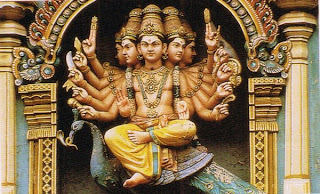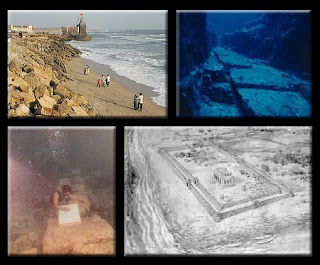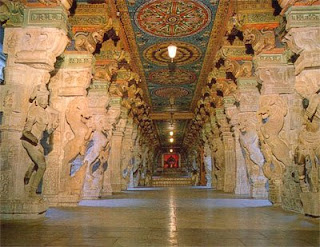
CHENNA KESAVA TEMPLE
The large temple in Belur is one of the most remarkable
monuments from Hoysala times and region. It was commissioned by the Hoysala king himself to celebrate an important military victory in 1117 AD. This is exceptional, since nearly all other Hoysala temples were commissioned by rich officials or rich civilians. The king obviously wanted an extraordinary temple because it has been built in an architectural style foreign to the region. Moreover the monument is exceptionally large and its decoration very lavish. Many of the decorations were added later in the 12th century by the grandson and successor of the founder.
The Cennakesava-temple stands in a compound with several smaller temples and a pond.
PlanThe monument consists of a shrine, an open hall and a platform. The shrine (vimana, mulaprasada) is larger than usual, its pedestal measures about 10 by 10 meters while a more usual size is 5 by 5 meters. Its architectural style is Nãgara (North Indian) but this is rather difficult to see because its tower is lost. The hall (mandapa) is of the open type, originally it only had a parapet. Later on the space between parapet and roof has been closed-off with magnificent screens, together with the further embellishment of the temple. The platform (jagati) is an essential part of the over-all design of the monument. It forms a unity with the rest of the elevation because it carefully follows the outlines of the shrine and the hall. Its three flights of steps add dignity to the entrances of the hall and it provides a walkway around the shrine (pradakshinapatha). Circumambulation of the shrine is an important form of worship.
The shrineThe design of the shrine was exceptional for the times and the region. It is Nãgara with a stellate plan. Both these aspects deserve separate notice.
Stellate plans were new for southern Karnataka in 1117 AD but not uncommon in the north of Karnataka and in northern India. The kind of star found here differs from the northern examples because it is a 16-pointed interrupted star. Basically, the plan is a square. Including the projections that form the corners, each side of this square has five projections (bhadras, rathas). Of these, the intermediate projections are rotated through 22.5 degrees. The difference with a full star is the central projections that are not rotated but just orthogonal instead . In northern India, the most common form of stellate plan is also interrupted but 32-pointed. In that case the rotation of the projections is in steps of 11.25 degrees.
The Nãgara design of the shrine was also new to the region. The most striking element of this design is missing today because the tower of the shrine is gone. It had a curvilinear outline and consisted of a central vertical band and four columns of miniature Nãgara Ñikharas per side. This kind of tower is called Bumija and is also found on some of the miniature shrines flanking the entrances of this temple. The Nãgara design of the large shrine is still visible in the articulation of its walls: each projection is articulated as a pillar. This gives the walls a very different character compared to shrines with a Dravida (South Indian) design, the design common to all regions of southern India including southern Karnataka.
Also new is the decoration of the walls of the shrine with a row of large images. In earlier temples in southern India the walls were provided with niches, and only inside the niches there are large images of gods. The wall-images of the Cennakesava-temple are one of the large sculptural attractions of the monument. Their number is about 80, each projection and each recess of the shrine has one. It is on the southern side that the most striking depictions are found, among them Shiva dancing on a demon (Andhakasura), a horribly emaciated dancing Kali, a seated Ganesha, a pair consisting of a boy with umbrella and a king (Vamana avatara of Vishnu), Ravana shaking mount Kailasa (Ravana Anugraha murti), Durga slaying the buffalo demon (Mahisasuramardini), a straight-standing Brahma, a boar saving the goddess earth (Varaha avatara of Vishnu). The most impressive and most venerated wall-images are on the two faces of the south-western corner of the shrine: Vishnu slaying king Hiranayakasipu (Narasimha avatara) and Shiva slaying the elephant demon . On the western and northern sides the images are less impressive and show less variation. Here two times a naked Shiva (Bhairava), Surya, another Varaha and another Andhakasura are the most remarkable.
In ornate Hoysala temples depiction of numerous gods and attendants in a horizontal row of large images is usual, here in Belur this is found for the first time. Though the temple is dedicated to Vishnu, all gods of the Hindu pantheon are represented. The sculptural style of the wall-images is not yet the typical Hoysala style of later times. Comparison with other regions show that it is close to the style of similar wall-images of contemporary temples in the extreme north of Karnataka and in adjacent Maharashtra.
The hallAlso the hall of the temple is very large and very ornate. Originally it was an open hall without full walls, it had a parapet-wall and a roof only resting on pillars. Its plan is not a square but a stepped diamond, which is usual in this kind of open halls. The parapet-wall is very high in this case, more than two meters, and is topped with a slanting seat-back. This seat-back is decorated with panels showing mythological scenes. Below it are numerous horizontal bands with lavish sculptural decorations and depictions, some of them extremely delicate.
Above the seat-back elaborate screens are found, added later in the 12th century and making the interior of the hall dark and mysterious. Additions from the same times are the world-famous bracket-figures (mandanakai) found at the top of the pillars between the screens. These sculptures, about 40 in number, are so delicate that it seems nearly impossible that they are made of stone. Evidently the sculptors of these miniatures also considered them as a tour de force and sometimes provided them with boasting texts. Many of this bracket-figures are signed by their artist.
The hall has three majestic entrances, each with two flights of steps, one up to the platform and one up to the floor level of the hall. These flights of steps are flanked by miniature shrines. The doorways are elaborate and especially their lintels are masterpieces of delicate sculpture. They show avataras of Vishnu in the centre of an arch of foliage (torana). The arches spring from the mouths of two water monsters (makaras).


chenna kesava temple,karnataka


MADURAI MEENAKSHI TEMPLE
Meenakshi Temple of madurai,Tamilnadu is the abode for sculptural excellence.This massive temple with magnificent pillars,thousand pillar mandapams, beaming temple towers ,well built temple tanks ,all speak volumes of perfected sculptural art of india.This temple has saptha swara pillars made of rock,which reverberates with seven musical notes
meenakshi temple

meenakshi temple

meenakshi temple

meenakshi temple


meenakshi temple





















































